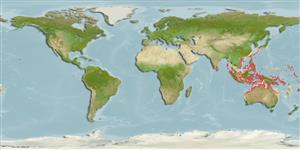Teleostei (teleosts) >
Ovalentaria/misc (Various families in series Ovalentaria) >
Pseudochromidae (Dottybacks) > Pseudoplesiopinae
Eponymy: AMS is institutional code in ichthyology for the Australian Museum (Sydney). [...] Ronald Knight, Sr. of Manus, Papua New Guinea, was honoured “for his generous hospitality during a collecting visit to the island in 1982.” (Ref. 128868), visit book page.
Environment: milieu / climate zone / depth range / distribution range
Ecology
Marine; reef-associated; depth range 10 - 30 m (Ref. 90102). Tropical
Western Pacific: Philippines (Ref. 48613) to northern Australia (including Western Australia) and Papua New Guinea to Solomon Islands (Ref. 90102).
Size / Weight / Age
Maturity: Lm ? range ? - ? cm
Max length : 4.5 cm TL male/unsexed; (Ref. 48635)
Found in coastal reef slopes amongst algae boulder habitat to about 20 m depth (Ref. 48635); also inhabits inshore reefs (Ref. 7300). Cryptic and seen with the use of collecting chemicals (Ref 90102).
Life cycle and mating behavior
Maturity | Reproduction | Spawning | Eggs | Fecundity | Larvae
Paxton, J.R., D.F. Hoese, G.R. Allen and J.E. Hanley, 1989. Pisces. Petromyzontidae to Carangidae. Zoological Catalogue of Australia, Vol. 7. Australian Government Publishing Service, Canberra, 665 p. (Ref. 7300)
IUCN Red List Status (Ref. 130435: Version 2024-2)
Threat to humans
Harmless
Human uses
Fisheries: of no interest
Tools
Special reports
Download XML
Internet sources
Estimates based on models
Preferred temperature (Ref.
123201): 25.4 - 29, mean 28 °C (based on 268 cells).
Phylogenetic diversity index (Ref.
82804): PD
50 = 1.0000 [Uniqueness, from 0.5 = low to 2.0 = high].
Bayesian length-weight: a=0.01995 (0.00906 - 0.04395), b=3.01 (2.83 - 3.19), in cm total length, based on all LWR estimates for this body shape (Ref.
93245).
Trophic level (Ref.
69278): 3.3 ±0.5 se; based on size and trophs of closest relatives
Fishing Vulnerability (Ref.
59153): Low vulnerability (10 of 100).
Nutrients (Ref.
124155): Calcium = 217 [102, 392] mg/100g; Iron = 1.11 [0.61, 2.03] mg/100g; Protein = 18.4 [17.1, 19.7] %; Omega3 = 0.146 [0.073, 0.282] g/100g; Selenium = 26.5 [11.5, 55.4] μg/100g; VitaminA = 98.1 [26.6, 359.1] μg/100g; Zinc = 2.2 [1.4, 3.4] mg/100g (wet weight);
